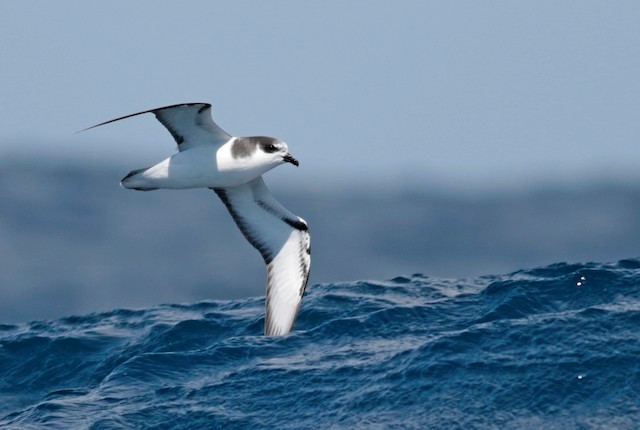Birdfinding.info ⇒ Locally common around its sole breeding colony on Isla Alejandro Selkirk and less so around neighboring Isla Robinson Crusoe, both over 400 miles west of the Chilean mainland. Otherwise generally difficult to find despite its large range and numbers. It can sometimes be found a few miles from the Chilean coast on boat trips out of Talcahuano and southward. There are several records from Hawaiian waters offshore from the main islands, especially in September and October, when it should be looked for on trips out of Honolulu and Kailua-Kona.
Stejneger’s Petrel
Pterodroma longirostris
Breeds in the Juan Fernández Islands and winters in the northwestern Pacific.
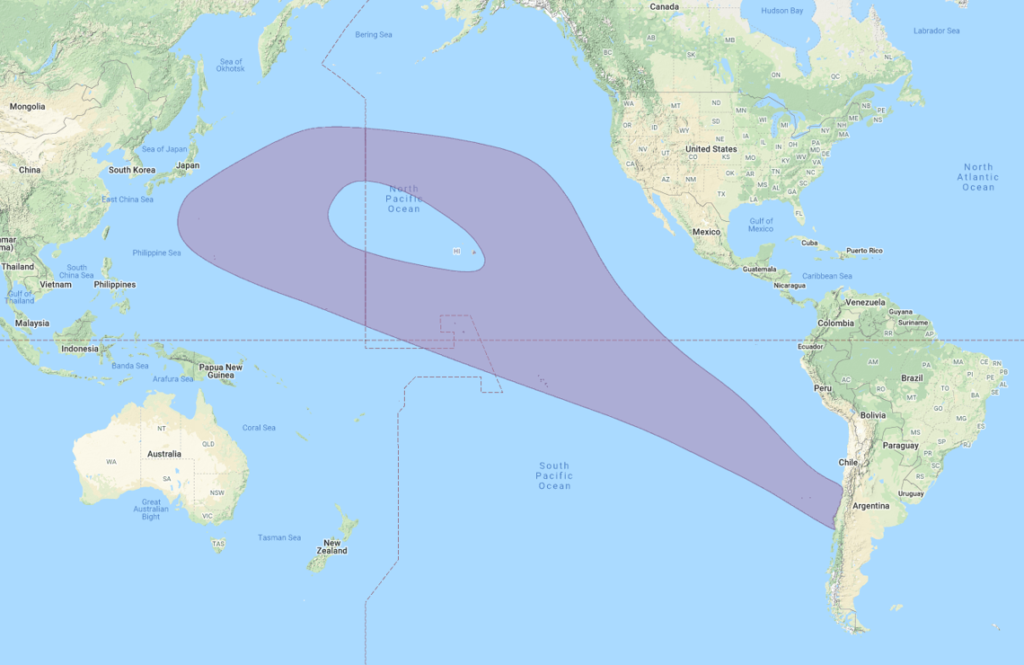
Approximate at-sea distribution of Stejneger’s Petrel. © Xeno-Canto 2021
Breeding. Breeds from November to May on Isla Alejandro Selkirk (a.k.a. Masafuera), the more distant of the two main Juan Fernández Islands. Nests alongside the Juan Fernández Petrel in burrows on slopes in fern-forest, fern-scrub and adjacent meadows and ridges at 850-1,100 m elevations of Cerro de los Inocentes.
The global population is fairly large, estimated in 1987 at 655,000 individuals, but is thought to be in a steady long-term decline, primarily due to predation by invasive mammals: cats, rats, mice, and dogs.
Nonbreeding. Most of the population is believed to spend June through September far offshore in the northwestern Pacific, in the Oyashio-Kuroshio Extension Current southeast of Japan.
Their main wintering area is remote enough that they are rarely detected during this season even around Japan’s distant oceanic islands. Typhoons have occasionally transported significant numbers to the coast of Honshu.
Movements. The general pattern of migration around the Pacific appears to be counterclockwise. In April and May, they depart roughly west-northwest from Chilean waters through Polynesia, passing mostly south of Hawaii. When returning in September and October, they pass through Hawaiian waters, then turn south.
Wanderers have been recorded several times in the northeastern Pacific, in the waters off of Oregon and California, mainly in October and November, and on the opposite side of the ocean in the southwestern Pacific, in the waters of New Zealand, eastern Australia, and Tasmania. There are enough records to suggest that low numbers may occur regularly in both regions.
One extraordinary vagrant was found dead on the Gulf of Mexico shore of Nueces County, Texas (September 15, 1995).
Identification
A small, thin gadfly petrel with strongly patterned gray-and-black upperparts and white underparts.
The upperparts are mostly pale to medium-gray with a pronounced blackish “M” pattern: dark bars the full length of the wing connected by a dark bar on the lower back, accentuated by paler trailing edges on the secondaries.
The rump is pale-gray, and the tail is mostly blackish—which distinguishes it from its most similar relatives.

Stejneger’s Petrel. (Offshore from Isla Alejandro Selkirk, Chile; November 2014.) © Kirk Zufelt
The crown, nape, and sides of the neck are medium to dark-gray—with darker, blackish shadows around the eyes. The forehead is white, extending onto the forecrown, above the front of the eye.

Stejneger’s Petrel. (Offshore from Robinson Crusoe Island, Chile; November 21, 2016.) © David Fisher
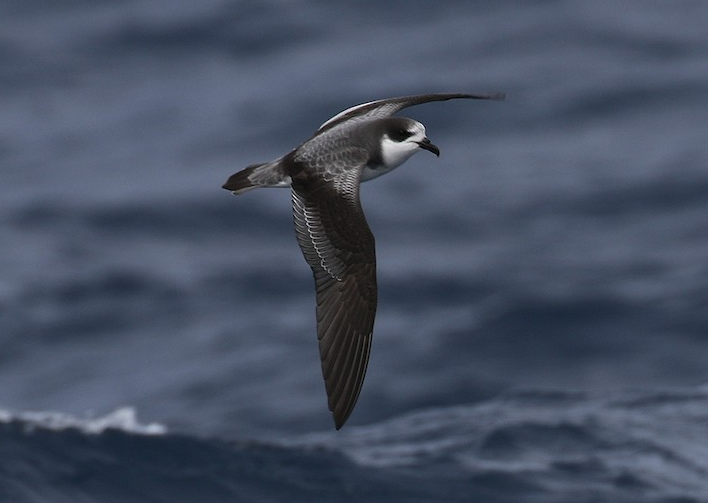
Stejneger’s Petrel. (Offshore from Robinson Crusoe Island, Chile; November 20, 2016.) © Fabrice Schmitt
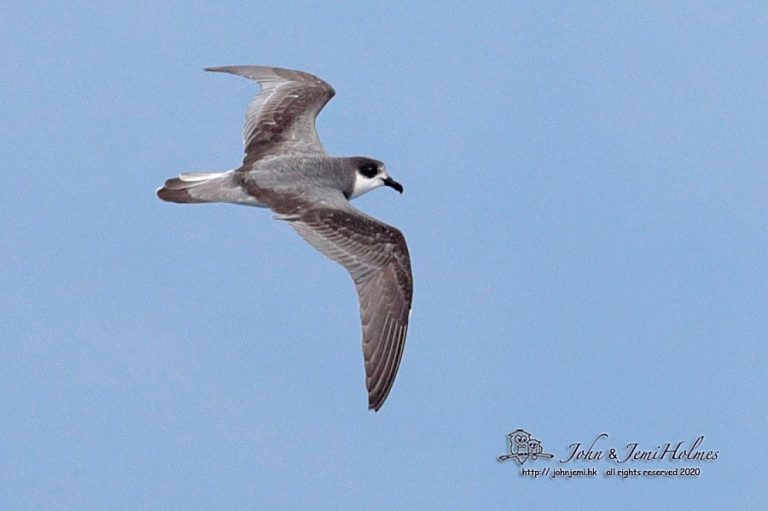
Stejneger’s Petrel. (Offshore from Robinson Crusoe Island, Chile; February 28, 2020.) © John & Jemi Holmes
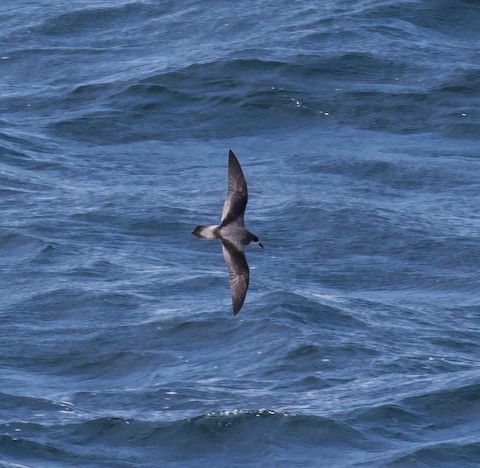
Stejneger’s Petrel. (Offshore from Chiloé Island, Chile; February 4, 2020.) © Gary Rosenberg
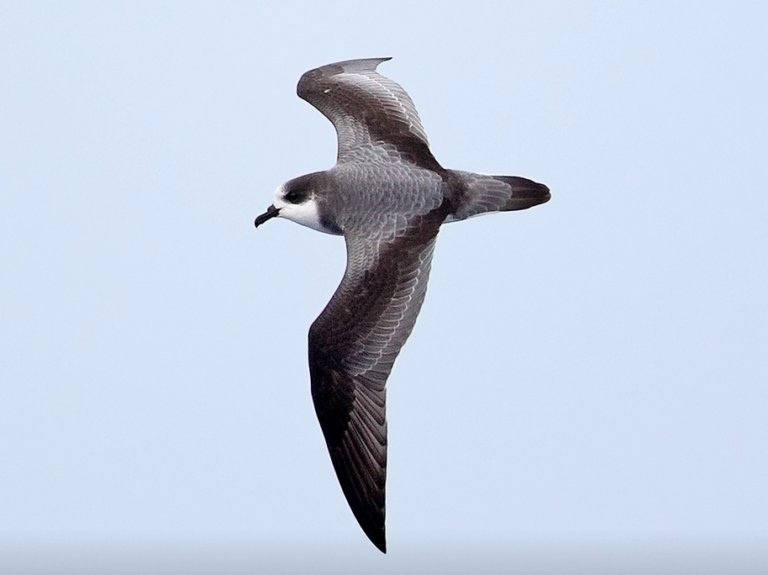
Stejneger’s Petrel. (Offshore from Henderson Island, Pitcairn Islands; November 2014.) © Geoff Jones
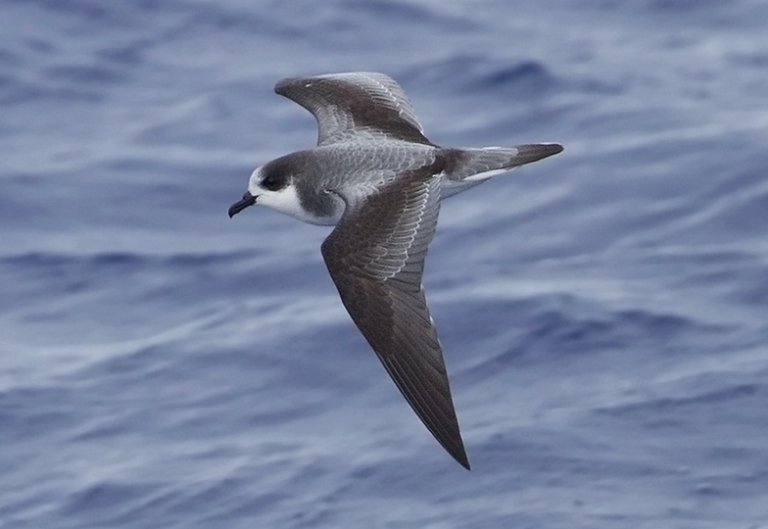
Stejneger’s Petrel. (Offshore from Henderson Island, Pitcairn Islands; November 2014.) © Geoff Jones

Stejneger’s Petrel. (Offshore from Henderson Island, Pitcairn Islands; November 2014.) © Geoff Jones

Stejneger’s Petrel. (Offshore north of Kiribati; October 7, 2017.) © Bert Wessling

Stejneger’s Petrel. (West-southwest of Laysan Island, Hawaii; October 10, 2010.) © Sophie Webb
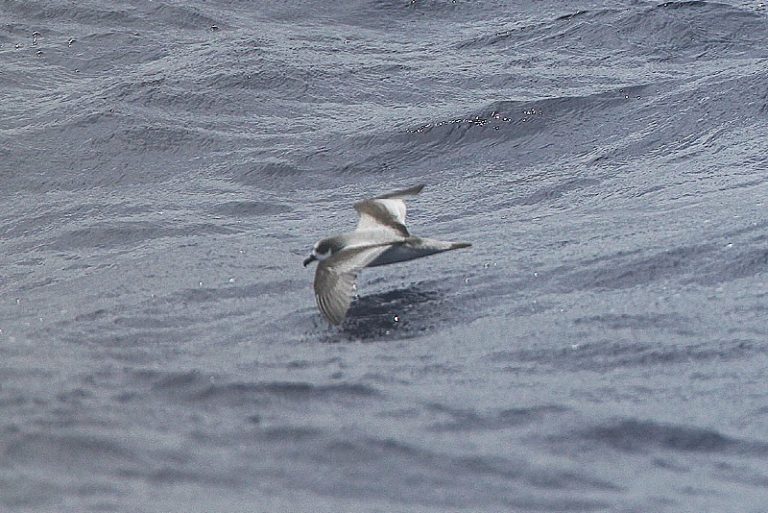
Stejneger’s Petrel. (Offshore from Moku Manu, Oahu, Hawaii; September 22, 2010.) © Michael Walther

Stejneger’s Petrel, showing prominent white forehead. (Offshore ~500 miles west of the Galápagos Islands, Ecuador; May 4, 2017.) © Mike Greenfelder

Stejneger’s Petrel. (Offshore from Bío Bío, Chile; March 3, 2018.) © Noam Markus

Stejneger’s Petrel, showing prominent white forehead. (Offshore ~500 miles south of the Big Island, Hawaii; June 4, 2019.) © Mike Greenfelder
The underparts are essentially all-white, with a gray cowl that extends down the sides of the neck.
The underwings are white overall with a thin, often broken, blackish carpal bar and thin blackish leading and trailing edges.

Stejneger’s Petrel. (Offshore from Southport, Queensland, Australia; November 2017.) © Matthias Dehling
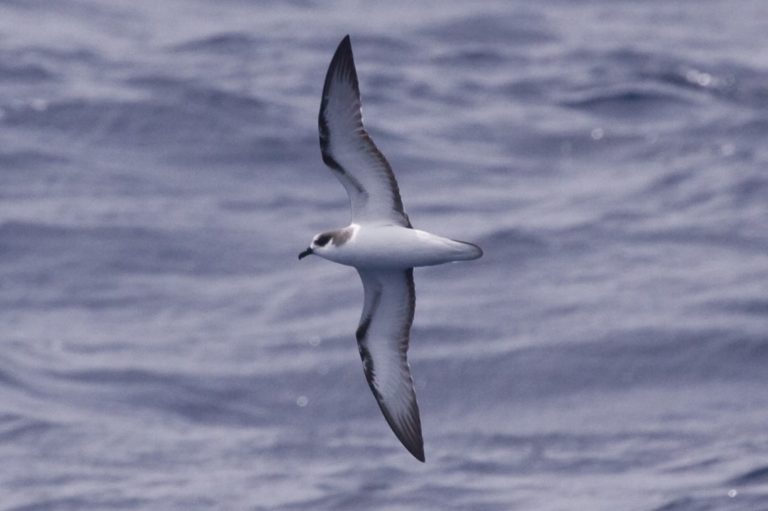
Stejneger’s Petrel. (Offshore from Moku Manu, Oahu, Hawaii; September 22, 2010.) © Eric VanderWerf

Stejneger’s Petrel. (Offshore from Robinson Crusoe Island, Chile; January 9, 2017.) © Fernando Díaz (Albatross Birding Chile)

Stejneger’s Petrel. (Offshore from Mooloolaba, Queensland, Australia; November 5, 2011.) © Brian Russell

Stejneger’s Petrel. (Offshore from Robinson Crusoe Island, Chile; November 21, 2016.) © David Fisher

Stejneger’s Petrel. (Offshore from Robinson Crusoe Island, Chile; February 28, 2020.) © John & Jemi Holmes
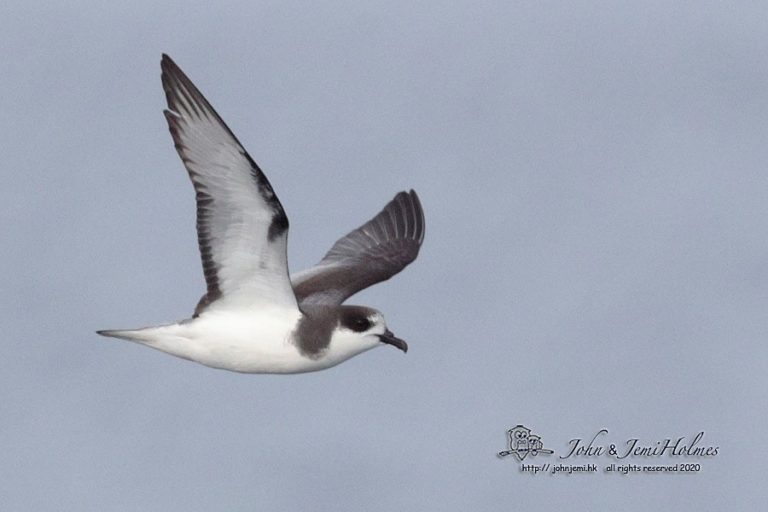
Stejneger’s Petrel. (Offshore from Robinson Crusoe Island, Chile; February 28, 2020.) © John & Jemi Holmes

Stejneger’s Petrel. (Offshore from Isla Alejandro Selkirk, Chile; November 2014.) © Kirk Zufelt

Stejneger’s Petrel. (Offshore from Robinson Crusoe Island, Chile; February 28, 2020.) © John & Jemi Holmes

Stejneger’s Petrel. (Offshore from Robinson Crusoe Island, Chile; February 28, 2020.) © John & Jemi Holmes
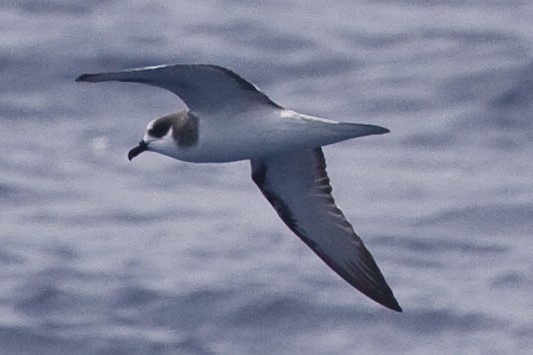
Stejneger’s Petrel. (Offshore from Moku Manu, Oahu, Hawaii; September 22, 2010.) © Eric VanderWerf
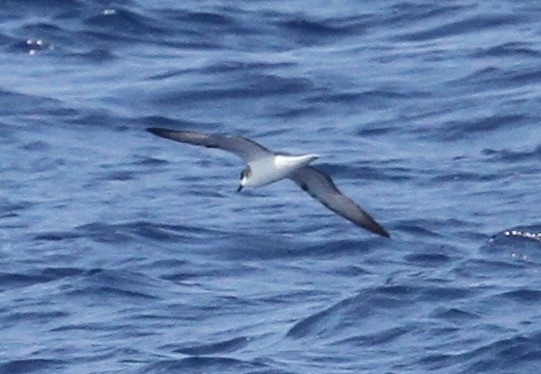
Stejneger’s Petrel. (Offshore from Kailua-Kona, Big Island, Hawaii; May 11, 2013.) © Daniel L. Webster / Cascadia Research Collective
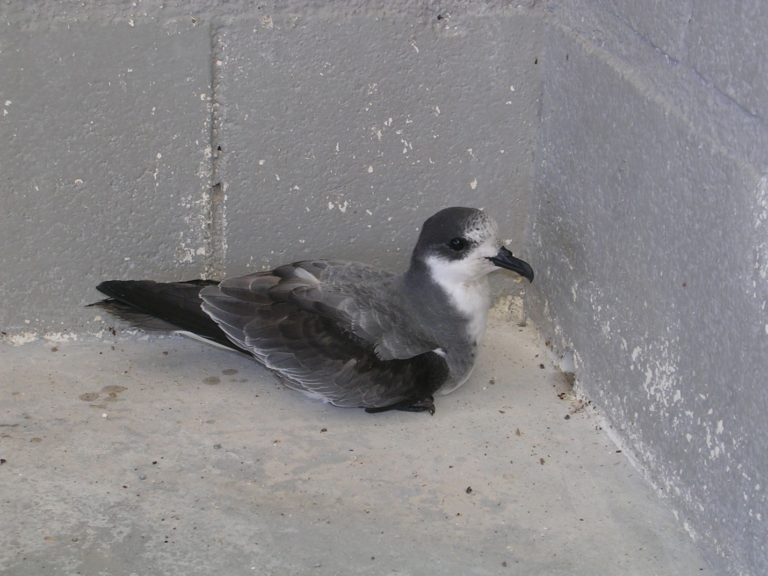
Stejneger’s Petrel. (Rescued on Oahu, Hawaii; October 7, 2005.) © Sea Life Park

Stejneger’s Petrel. (Isla Alejandro Selkirk, Chile.) © Peter Hodum
Cf. Pycroft’s Petrel. Pycroft’s and Stejneger’s Petrels were traditionally considered conspecific and are extremely similar. They are not known to overlap regularly, but they probably do: Stejneger’s has been recorded on multiple occasions in the southwestern Pacific, and Pycroft’s nonbreeding range is essentially unknown, but likely included some portions of the central and northwestern Pacific where Stejneger’s occurs. The most consistent difference between them is tail color: Stejneger’s has a distinctly blackish tail that contrasts with its paler-gray rump, whereas Pycroft’s usually shows only a slightly darker tail, with little if any contrast. At the other end, Stejneger’s has a much more extensively white forehead—this seems to be diagnostic, but is difficult to see clearly under most field conditions.
Cf. Cook’s Petrel. Cook’s and Stejneger’s Petrels overlap widely across most of the Pacific Ocean and are easily mistaken for one another. Stejneger’s is slightly smaller in all dimensions, but this would rarely be useful under field conditions. The more helpful differences between them are plumage features: especially the color and pattern of the upperparts. Stejneger’s is darker overall and has a strongly contrasting pattern: a bold, blackish “M” across the wings and back; a blackish tail (both darker and more extensive than on Cook’s). The coloration and pattern of the head and neck also differ. In this area Cook’s is a paler shade of gray overall, which accentuates the dark shadows around its eyes, and Cook’s usually shows a distinct white brow. Stejneger’s usually shows a dark cap and cowl with an extensively white forehead that may reach the eye, but not a pale brow.
Cf. De Filippi’s Petrel. Stejneger’s and De Filippi’s Petrels occur together in the Humboldt Current waters west of South America and elsewhere in the southeastern Pacific. They have approximately the same overall appearance, but differ in a few details. De Filippi’s is slightly larger and heavier and has a thicker bill. De Filippi’s has slightly paler upperparts, most noticeable at the head and tail. Perhaps most noticeable in the field, De Filippi’s rump and tail are both pale to medium-gray, whereas Stejneger’s has a blackish tail that contrasts with its paler rump. On the head, De Filippi’s has a pale-gray crown and cowl, which on Stejneger’s are medium or dark-gray. Finally, De Filippi’s has a pronounced white browline, which isolates and accentuates the blackish shadow around its eye.
Cf. Gould’s Petrel. Gould’s and Stejneger’s Petrels are similar species that overlap to some extent across most of the tropical Pacific. Both have dark-gray cowls, which distinguish them from most related species, but Gould’s has a darker cowl that typically extend farther down the neck—and on some individuals may form a complete collar. Gould’s also has generally darker-gray upperparts that show less contrast than Stejneger’s, so the M-pattern on Gould’s is less pronounced and its rump and tail do not contrast strongly, as on Stejneger’s. Finally, on the underside of its wings, Gould’s has wider black carpal bars.
Notes
Monotypic species.
IUCN Red List Status: Vulnerable.
References
Aves de Chile. 2021. Fardela de Más Afuera. https://www.avesdechile.cl/441.htm. (Accessed May 15, 2021.)
Bartle, J.A. 2013. Stejneger’s petrel. In New Zealand Birds Online (Miskelly, C.M., ed.). http://nzbirdsonline.org.nz/species/stejnegers-petrel. (Accessed May 15, 2021.)
BirdLife International. 2019. Pterodroma longirostris. The IUCN Red List of Threatened Species 2019: e.T22697997A152684668. https://dx.doi.org/10.2305/IUCN.UK.2019-3.RLTS.T22697997A152684668.en. (Accessed May 15, 2021.)
Brazil, M. 2009. Birds of East Asia. Princeton University Press.
Brooke, M. 1987. Population estimates and breeding biology of the petrels Pterodroma externa and P. longirostris on Isla Alejandro Selkirk, Juan Fernandez archipelago. Condor 89:581-586.
Brooke, M. 2004. Albatrosses and Petrels across the World. Oxford University Press.
eBird. 2021. eBird: An online database of bird distribution and abundance. Cornell Lab of Ornithology, Ithaca, N.Y. http://www.ebird.org. (Accessed May 15, 2021.)
Harrison, P. 1983. Seabirds: An Identification Guide. Houghton Mifflin, Boston.
Howell, S.N.G. 2012. Petrels, Albatrosses & Storm-Petrels of North America. Princeton University Press.
Howell, S.N.G., I. Lewington, and W. Russell. 2014. Rare Birds of North America. Princeton University Press.
Howell, S.N.G., and K. Zufelt. 2019. Oceanic Birds of the World. Princeton University Press.
Jaramillo, A. 2003. Birds of Chile. Princeton University Press.
Onley, D., and P. Scofield. 2007. Albatrosses, Petrels & Shearwaters of the World. Princeton University Press.
Pratt, H.D., P.L. Bruner, and D.G. Berrett. 1987. A Field Guide to the Birds of Hawaii and the Tropical Pacific. Princeton University Press.
Pyle, R.L., and P. Pyle. 2017. The Birds of the Hawaiian Islands: Occurrence, History, Distribution, and Status. Version 2 (January 1, 2017). http://hbs.bishopmuseum.org/birds/rlp-monograph/. B.P. Bishop Museum, Honolulu, Hawaii.
Schulenberg, T.S., D.F. Stotz, D.F. Lane, J.P. O’Neill, and T.A. Parker. 2007. Birds of Peru. Princeton University Press.
Seabirding of Japan. 2021. Stejneger’s Petrel. http://seabirding-japan.com/stejnegers-petrel/. (Accessed May 15, 2021.)
Xeno-Canto. 2021. Stejneger’s Petrel – Pterodroma longirostris. https://www.xeno-canto.org/species/Pterodroma-longirostris. (Accessed May 15, 2021.)

